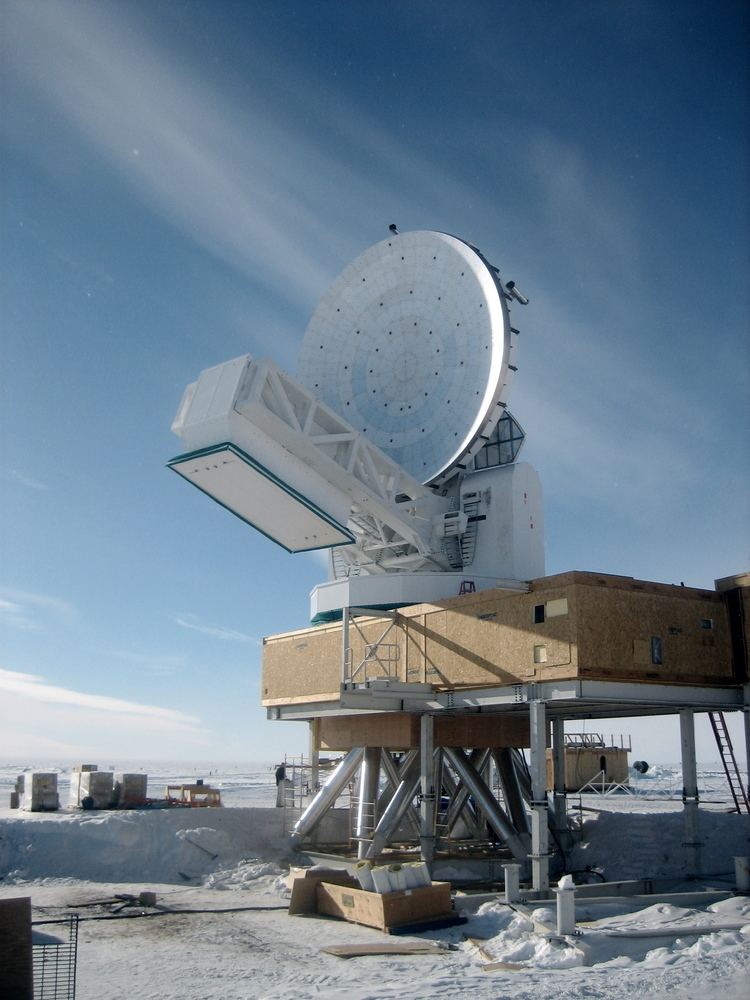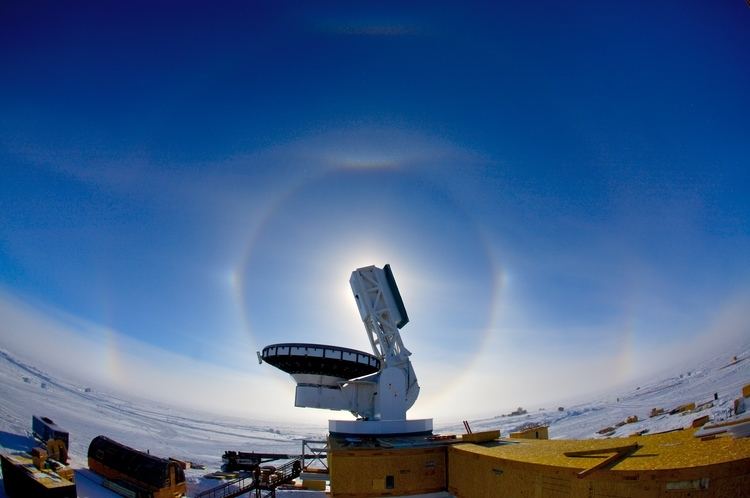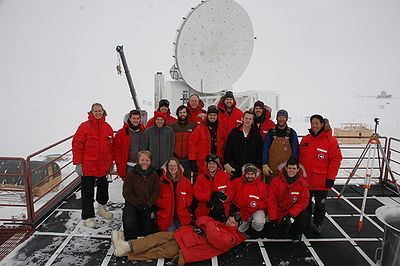Named after South Pole First light 16 February 2007 | Altitude 2.8 km (9,200 ft) | |
 | ||
Built November 2006–February 2007 (November 2006–February 2007) Telescope style | ||
Nibiru is real the south pole telescope tracking nibiru
The South Pole Telescope (SPT) is a 10 meter (394 in) diameter telescope located at the Amundsen–Scott South Pole Station, Antarctica. The telescope is designed for observations in the microwave, millimeter-wave, and submillimeter-wave regions of the electromagnetic spectrum, with the particular design goal of measuring the faint, diffuse emission from the cosmic microwave background (CMB). The first major survey with the SPT–designed to find distant, massive, clusters of galaxies through their interaction with the CMB, with the goal of constraining the dark energy equation of state–was completed in October 2011. In early 2012, a new camera was installed on the SPT with even greater sensitivity and the capability to measure the polarization of incoming light. This camera is designed to measure the so-called "B-mode" or "curl" component of the polarized CMB, leading to constraints on the mass of the neutrino and the energy scale of inflation.
Contents
- Nibiru is real the south pole telescope tracking nibiru
- Microwavemillimeter wave observations at the South Pole
- The telescope
- The SPT SZ camera
- The SPTpol camera
- Science goals
- Funding
- Current status
- References
The SPT collaboration is made up of over a dozen (mostly North American) institutions, including the University of Chicago, the University of California-Berkeley, Case Western Reserve University, Harvard/Smithsonian Astrophysical Observatory, the University of Colorado-Boulder, McGill University, The University of Illinois at Urbana-Champaign, University of California at Davis, Ludwig Maximilian University of Munich, Argonne National Laboratory, and the National Institute for Standards and Technology. It is funded by the National Science Foundation.

Microwave/millimeter-wave observations at the South Pole

The South Pole is the premier observing site in the world for millimeter-wavelength observations. The Pole's high altitude (2.8 km/1.7 mi above sea level) means the atmosphere is thin, and the extreme cold keeps the amount of water vapor in the air low. This is particularly important for observing at millimeter wavelengths, where incoming signals can be absorbed by water vapor, and where water vapor emits radiation that can be confused with astronomical signals. Because the sun does not rise and set daily, the atmosphere at the pole is particularly stable. Further, there is no interference from the sun in the millimeter range during the months of polar night.
The telescope

The telescope is a 10-meter (394 in) diameter off-axis Gregorian telescope in an altazimuth mount (at the poles, an altazimuth mount is effectively identical to an equatorial mount). It was designed to allow a large field of view (about 1 square degree) while minimizing systematic uncertainties from ground spill-over and scattering off the telescope optics. The surface of the telescope mirror is smooth down to roughly 25 micrometers (one thousandth of an inch), which allows sub-millimeter wavelength observations. The secondary mirror is cooled to 10 K, and metal mesh filters block excess high frequency radiation to keep the thermal loading on the camera down. A key advantage of the SPT observing strategy is that the entire telescope is scanned, so the beam does not move relative to the telescope mirrors. The fast scanning of the telescope and its large field of view makes SPT efficient at surveying large areas of sky, which is required to achieve the science goals of the SPT cluster survey and CMB polarization measurements.
The SPT-SZ camera
The first camera installed on the SPT contained a 960-element bolometer array of superconducting transition edge sensors (TES), which made it one of the largest TES bolometer arrays ever built. The focal plane for this camera (referred to as the SPT-SZ camera because it was designed to conduct a survey of galaxy clusters through their Sunyaev-Zel'dovich Effect signature) was split into six pie-shaped wedges, each with 160 detectors. These wedges observed at three different frequencies: 95 GHz, 150 GHz, and 220 GHz. The modularity of the focal plane allowed it to be broken into many different frequency configurations. For the majority of the life of the camera, the SPT-SZ focal plane had one wedge at 95 GHz, four at 150 GHz, and one at 220 GHz.
The SPTpol camera
The camera currently installed on the SPT–also designed with superconducting TES arrays–is even more sensitive than the SPT-SZ camera and, crucially, has the ability to measure the polarization of the incoming light (hence the name SPTpol - South Pole Telescope POLarimeter). The 780 polarization-sensitive pixels (each with two separate TES bolometers, one sensitive to each linear polarization) are divided between observing frequencies of 90 GHz and 150 GHz, and pixels at the two frequencies are designed with different detector architectures. The 150 GHz pixels are corrugated-feedhorn-coupled TES polarimeters fabricated in monolithic arrays at the National Institute of Standards and Technology. The 90 GHz pixels are individually packaged dual-polarization absorber-coupled polarimeters developed at Argonne National Laboratory. The 90 GHz pixels are coupled to the telescope optics through individually machined contoured feedhorns.
Science goals
The first key project for the SPT, completed in October, 2011, was a 2500-square degree survey to search for clusters of galaxies using the Sunyaev-Zel'dovich effect, a distortion of the cosmic microwave background radiation (CMB) due to interactions between CMB photons and the Intracluster medium in galaxy clusters. The survey has found hundreds of clusters of galaxies over an extremely wide redshift range. When combined with accurate redshifts and mass estimates for the clusters, this survey will place interesting constraints on the Dark Energy equation of state. Data from the SPT-SZ survey have also been used to make the most sensitive existing measurements of the CMB power spectrum at angular scales smaller than roughly 5 arcminutes (multipole number larger than 2000) and to discover a population of distant, gravitationally lensed dusty, star-forming galaxies.
The main science goal of the current SPTpol camera is to measure so-called "B-mode" or "curl" component of the polarized CMB. This B-mode signal is generated at small angular scales by the gravitational lensing of the much larger primordial "E-mode" polarization signal (generated by scalar density perturbations at the time the CMB was emitted) and at large angular scales by the interaction of the CMB with a background of gravitational waves produced during the epoch of inflation. Measurements of the small-scale B-mode signal can place stringent constraints on the growth of structure between the time the CMB was emitted and today, and, in doing so, constrain cosmological parameters that influence structure growth, including the sum of the neutrino masses. Using data from the first season of SPTpol observations, the SPT team recently reported the first detection of the lensing B-mode signal. Measurements of the large-scale B-mode signal have the potential to constrain the energy scale of inflation, thus probing the physics of the universe at the earliest times and highest energy scales imaginable.
The Atacama Cosmology Telescope has similar, but complementary, science objectives.
Funding
The South Pole Telescope is funded through the National Science Foundation Office of Polar Programs with additional support from the Kavli Foundation and the Gordon and Betty Moore Foundation. The telescope cost $19.2 million. A budget document from FY2008 concerning South Pole Station Modernization projected expenses of around $16 million per year.
Current status
The South Pole Telescope achieved first light on February 16, 2007, and began science observations in March 2007. Commissioning observations and an initial small survey were completed in austral winter 2007 with winter-overs Stephen Padin and Zak Staniszewski at its helm. Larger survey fields were completed in 2008 with winter-overs Keith Vanderlinde and Dana Hrubes, and in 2009 with winter-overs Erik Shirokoff and Ross Williamson. The camera was upgraded again in December 2009 for the 2010 observing season, and the full 2500 square-degree SPT-SZ survey was completed in the 2010 and 2011 observing seasons with winter-overs Dana Hrubes and Daniel Luong-Van.
First light (the first observation) was achieved with the SPTpol camera on January 27, 2012. During the first season of observations, the winterover crew, Cynthia Chiang and Nicholas Huang, took data on a 100 square degree survey field. As of 2013, 2013 winterovers Dana Hrubes and Jason Gallicchio are surveying a larger field as part of the full SPTpol survey.
